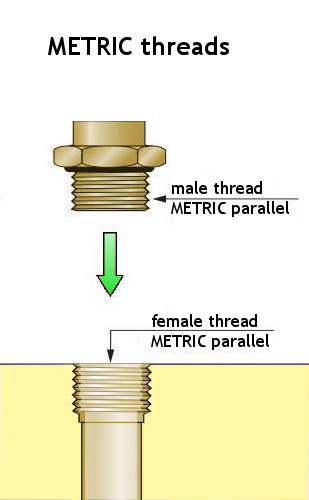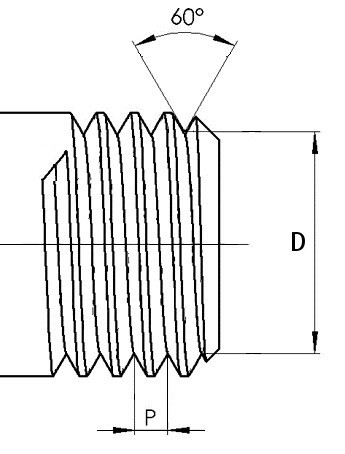
After describing BSP and NPT threads, the most commonly used threads for joining pipes, we would like to introduce the metric thread, with ISO profile, of cylindrical type and the most usual among nuts and bolts.
Also known as “metric system threads” or “SI”, they belong to a family of thread pitch standardized in 1946, based on the International System of Units (ISU), beforehand called the Metric System, hence the “metric” denomination.
Like the NPT threads, the thread angle has 60º, however its edges are less pronounced, same as BSP ones: from thread high (H), 1/8 from maximal diameter and ¼ from minimal diameter are extracted, which provides a more rounded appearance.
Designation of the Metric Thread consists on letter M and pitch diameter in millimeters, separated by the multiplying symbol (x).
- Example: M 8x1 shows a thread metric type, diameter 8mm. and 1mm. thread pitch.
Specification of the Metric Thread is collected at regulations ISO 68-1 and ISO 965-1. At Metric Thread pressure tight joints are not made on the threads; it is required a sealant mean. The most usual is the use of joint, and less common a metal-metal contact.

ISO 68-1 metric thread - 60º thread angle
There are two groups of Metric Threads:
1- Thin. Thread with less pitch distance so more threads per axial distance, and less length of thread area. We know as axial distance the one that goes all over a complete turn of the screw. It can be designated as MB – the most common and with bigger pitch size- and MC, MD or ME, though all those old designation were grouped and are globally known as Metric Thin Pitch Thread. Following the previous example a designation could be: M 8x1.
2- Thick or normal. Thick or normal. It is that one with a bigger thread pitch, therefore less threads per axial distance, and more length of thread area. It can be designed as well as MA (Metric type A). The equivalent to the example with this type of thread would be M 8x1,25.
It is important to know that these thread groups haven’t got a better or worst quality among them; simply they differentiate by the thread size related to thread diameter and have different applications. Thin one is commonly used when there’s less space for screwing, for instance on thin walls.
This type of threads are used mainly in Europe, otherwise with the same shape and same differentiation, although with other dimensions and in inches, we find standards UNC (Unified National Course) of thick sort and UNF (Unified National Fine), both manufactured with ANSI standards and widely used in the United States. Following with the previous example M 8x1, the equivalent designations would be: 5/16 – 18 UNC and 5/16 – 24 UNF.
At rmmcia we manufacture BSP threads as per regulation ISO228, but we can manufacture metric threads upon request.
For more technical information feel free to check with us or refer directly to regulations.
You could be interested also in: TYPES OF THREADS: BSP THREADS.
You could be interested also in: TYPES OF THREADS (II): NPT THREADS.
